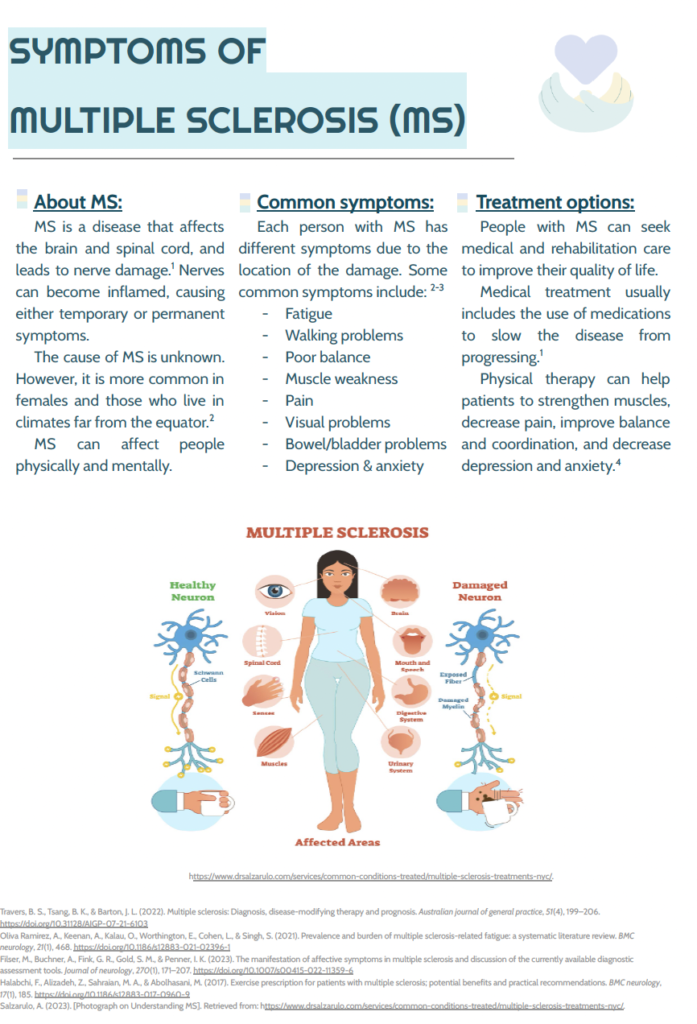BY Charlotte Rutherfurd, PT, DPT & Hina Garg, PT, PhD, NCS, CEEAA
Benefits of exercise in people with Multiple Sclerosis (MS) are well documented, especially in improving balance, safety, strength, endurance, and the overall wellbeing.¹
Refer to the image below to understand MS and related symptoms.

Although symptoms of MS are individualized and may fluctuate, there are key elements to a successful exercise program. Here are five tips to optimize your workout plan:
- Quantify your weekly physical activity.
30 minutes every weekday of aerobic exercise is recommended for people with MS.² Walking is one way to achieve this goal. But you don’t need to commute to the gym to get in your steps. Some easy ways to walk more are taking the stairs, parking farther away from the entrance in a parking lot, and suggesting a walk with friends as a social activity.
- Understand the intensity of your exercise.
In general, low intensity exercise is best tolerated by people with MS.³ Not “overdoing it” maintains the body’s internal temperature as well as reduces the risk for fatiguing too early. An indication of an appropriate workload is if you can comfortably hold a conversation during your workout. To learn other ways to exercise safely, consult a physical therapist.
- The best way to progress an exercise program is gradually.
Adjusting the workout frequencies, session length, and the type of exercise are all ways to bump up your program. Overall, progressing difficulty over weeks, not days, will increase workloads without negative, and potentially dangerous, side effects. Consult a physical therapist for ways to modify your exercises for the next level.
- Understand MS Fatigue, the most common symptom in people with MS.⁴
Fatigue is multifactorial and can manifest either from the disease progression, or secondarily, from other factors such as poor nutrition, stress and lack of sleep. There are many ways to control fatigue while exercising. Well-timed rest breaks or adjusting when you exercise are strategies. If no self-management strategies help and your fatigue gets worse, stop and talk to your healthcare team or physical therapist to assess if an exercise program is right for you.
- Control your body temperature.
Thermosensitivity, which is the loss of nerve cell conduction from raised core and ambient temperatures, is a common symptom experienced by people with MS. Exercising in a well-ventilated room with cooling fans is one strategy to self-regulate. Another is a morning workout, as core temperatures are lower at that time.⁵ Body cooling vests can be purchased as well for a direct contact cold transfer strategy.
Like this content? Share it with patients and providers!
References:
- Rietberg M, Brooks D, Uitdehaag B, Kwakkel G. Exercise therapy for multiple sclerosis. Cochrane Database of Systematic Reviews. 2005;(1). doi:10.1002/14651858.cd003980.pub2
- Ronai P, LaFontaine T, Bollinger L. Exercise Guidelines for Persons With Multiple Sclerosis. Strength Cond J. 2011;33(1):30-33. doi:10.1519/ssc.0b013e3181fd0b2e
- Halabchi F, Alizadeh Z, Sahraian MA, Abolhasani M. Exercise prescription for patients with multiple sclerosis; potential benefits and practical recommendations. BMC Neurol. 2017;17(1):185. Published 2017 Sep 16. doi:10.1186/s12883-017-0960-9
- Braley T, Chervin R. Fatigue in Multiple Sclerosis: Mechanisms, Evaluation, and Treatment. Sleep. 2010;33(8):1061-1067. doi:10.1093/sleep/33.8.1061
- Ronai P, LaFontaine T, Bollinger L. Exercise Guidelines for Persons With Multiple Sclerosis. Strength Cond J. 2011;33(1):30-33. doi:10.1519/ssc.0b013e3181fd0b2e
5,712 total views, 11 views today
